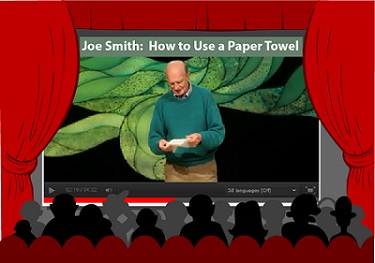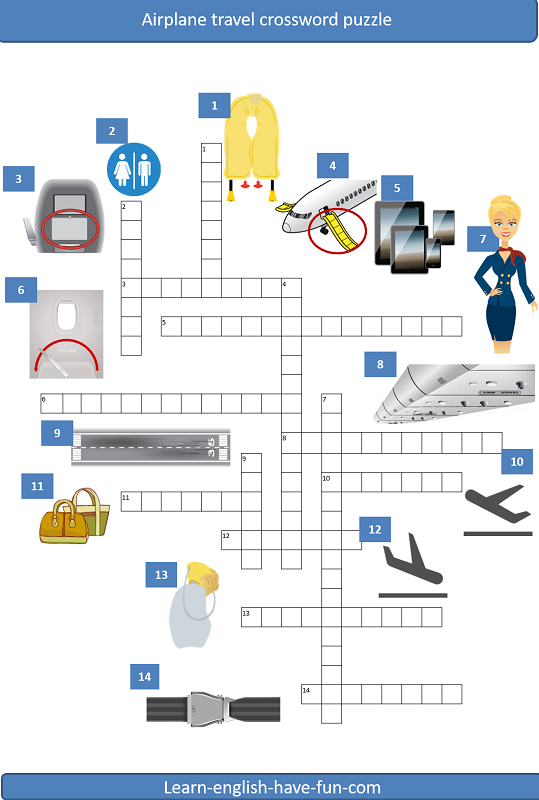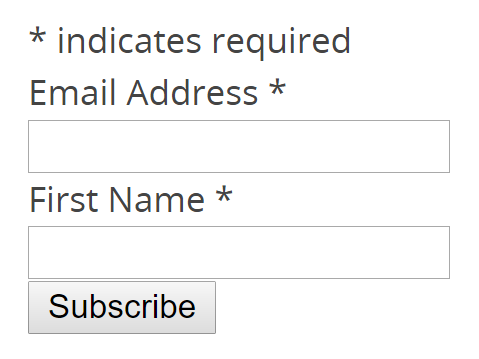Learn English Listening:
Improve your skills with these tips & tricks
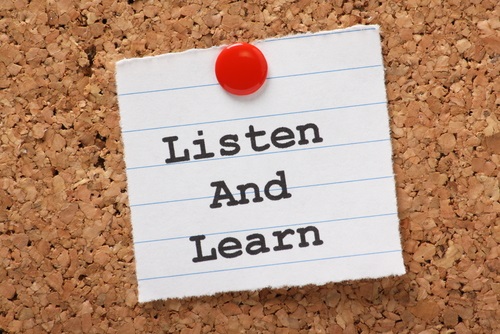
To learn English listening is a fundamental skill you need to develop.
The good news is that there are so many opportunities for you to practice and develop this important skill.
Here I will discuss some of the resources that I think are very useful and also highlight some of the lessons on my site that will also help you improve your listening.
Ready? Let's get started!
Learn English listening challenges for learners

Listening is an important skill in any language.
We listen for information for general understanding as well as to understand specific details.
Many students find it difficult to understand the radio, television, movies and videos.
Why?
Because spoken English in regular everyday speech is very different from how someone would sound trying to slowly and carefully say the same information.
This is also why sometimes it is easier for students to understand the news.
Connected Speech & Weak Forms
When we speak in every day English, we constantly shorten and connect our speech.
This is also why learners can sound more formal when they speak English because they don't speak the same way.
In English we often link words together to make our speech flow rhythmically and flow more easily out of our mouths.
We may change the sound at the end of one word to make it easier to say the next word.
Or we may join the last consonant of one word to the vowel of the next word.
For example, "I'd like an orange."
In regular speech, this sounds like: "I'd likuh norange."
"Likuh?" Never heard of that word. What's a "norange?" Is that some type of fruit?
This can be very confusing to students because they've never heard these words before and they're searching their brains for the vocabulary.
This is also why it is best to listen to, but not watch, a video to practice listening (so that you are only using your listening skills).
We also drop or lose sounds in natural speech, especially when there are many consonants together:
- "Grilled cheese sandwich" becomes "grillcheese sanwich"
- "Ham and cheese" becomes "hamn cheez."
- "What is in this sandwhich?" becomes "whatzin thi sanwich?"
We contract and connect "ham and" "what is in" and drop the "s" and "d" sounds in "grilled," "this" and "sandwich."
Learn English listening skill development
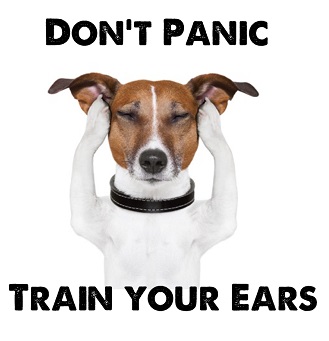
It's not as hard to train your ear as you think.
You've now learned that native English speakers frequently:
- contract words,
- drop sounds and
- connect speech
Your first practice step is to just start to notice this happening.
Later steps include targeted practice with minimal pairs (where only a vowel sound is changed - for example, sit -sat, or then-than).
Minimal pairs are very helpful for learners who do not have some of the sounds of English in their own language.
There are many lessons on YouTube to practice, just search for "minimal pairs."
General listening practice
It's simple to learn English listening by using a short video or audio that has a transcript. (You will find several suggestions of places to find videos with transcripts below.)
Please understand that you need to watch a single video SEVERAL times.
Do you understand that?
More than one time. If you can watch a single video 10-15 times, even BETTER. This is why selecting short videos is ideal.
Here are the general steps to listening to a video to develop your listening skills:
Step 1: Listen for the gist or general meaning
The idea is to only listen for the main point of what's being said.
- What is the person trying to say?
- Are they expressing an opinion?
- Are they giving information?
- Are they reporting an event?
- Are they describing something, etc.?
What is the speech about in general?
Step 2: Listen a second time for details
What are some of the supporting details about the speech?
Step 3: Train your ear for natural speech: contractions, weak forms, etc.
You can do this in many ways:
Look at a transcript of the audio to highlight parts of the text that you cannot hear clearly.
Is the speaker combining words together or dropping some of the sounds? Notice these forms and try to imitate the speaker with your own pronunciation.
Transcribe the speech: Try to write out the speech on paper. Even if you don't know the correct words, try to write down what you hear.
For example, if you write down: "I dunno whadzthuh best wayduh helper" you will see later on the transcript that the person actually said "I don't know what's the best way to help her."
It will help you notice that you do know all of those words but that they have been shorten in normal speech.
Use gap fills: Print out the transcript before you listen to the video or audio and use a some pieces of paper to cover up some of the words at random.
Then listen to the audio trying to fill in the missing words. You can also purchase books with recordings that have gap fills but it's very easy to create your own.
Step 4: Rinse and Repeat
Listen to an audio or video repeatedly.
Students often only listen to something once. Usually you only get the main idea if you listen to something one time.
But when you listen to something several times, you learn new words, notice speech patterns (as explained above) and your brain begins to hear and understand more and more of the speech.
It is better to listen to a short audio or video 5-10 times than to listen to something longer just one time.

Learn English listening learning resources
There are so many great resources out there but these are a few of my favorites.
The reason is that I believe having a transcript is a very valuable resource in developing listening skills.
As I mentioned above, listen several times to whatever audio or video you choose is THE key.
This is what we call PRACTICE.
Sorry to shout but many students never listen to this advice.
They don't want to practice and do things enough times to develop a skill. But of course YOU are not one of those students ;)
Right?
TED Talks
Ted Talks are fantastic because they let you hear people speak naturally.
They have prepared their speech but they are not reading something they wrote word for word.
So, you will hear normal pauses and expressions as well as the normal rhythms of spoken speech.
Not only do you get a transcript, but you can also turn on the English subtitles and in many cases, you can have a translation into your own language.
This can really help you quickly find the meaning of words you do not know.
I like TED Talks so much that I use them to create lessons on my website. Click here to access the video lessons.
Voice of America (VOA)
Voice of America offers captioned news reports, so these are English speakers using very clear speech.
They also have “English in a minute” videos which will help you to learn American idioms in just … you guessed it... one minute! Both are excellent for practicing listening.
British Broadcasting Corporation (BBC)
You probably know the BBC as they are renowned for their quality information.
The BBC has a good cartoon soap opera to help you develop your listening skills as well as a variety of videos with transcripts.
Audible
Audible is owned by Amazon.com and provides audio books by many popular authors.
You can easily find popular books in any topic or genre. It's a great investment to purchase the book in English as well so that you can read along with the recording.
Be sure to purchase the "unabridged" version of the book if you plan to read along.
"Abridged" recordings are shortened versions of the books.
I recommend trying to buy a book that you have already read in your own language (and hopefully will have on hand so you can use it to quickly look up words you do not know).
Oyster English's Podcasts
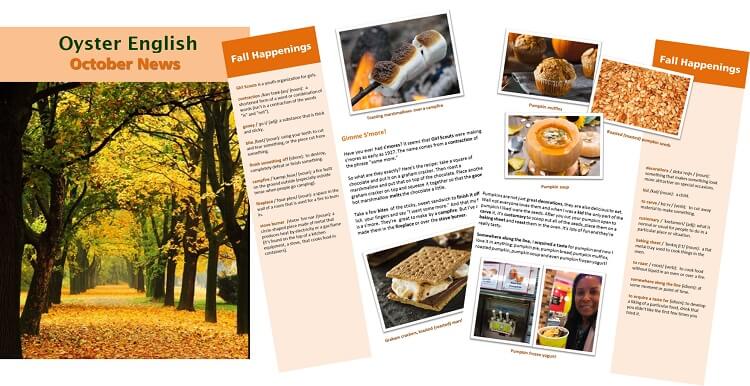
There are many English podcasts available on the internet and a few times a year I do a podcast myself with my newsletter.
If you have not yet signed-up, please enter your name and email in the form.
In these podcasts, I write a newsletter article and then read it so my learners have the opportunity to listen and learn as I have described on this page.
To see samples of the podcast and article, click on the links below:
Cherry Blossoms in Washington, DC
Other listening lessons
Here are a few more listening lessons that I've put together:
The English idiomatic expression, “beauty is only skin deep” means that a person’s inner beauty—not their outward physical appearance—is what’s most important. Academy Award winner Lupita Nyong’o discusses her personal struggle with feeling beautiful when she was growing up.
Practice your English listening with this video of Lady Gaga describing to Glamour Magazine what has made her feel beautiful and how she has struggled with her looks during her life. Take the short quiz to test your listening comprehension.
Flight attendant safety rap
This is a fun English listening exercise. Listen as the flight attendant raps (sings) the airline safety instructions before the flight. Test your listening comprehension with the quiz.
50 Shades of Hey
Listening and speaking are opposite sides of communication. In this listening exercise, you'll hear someone say "hey" 50 different times, producing many different meanings.
In this lesson you can practice listening to another airline safety message. It's an Australian accent this time.
When you're finished download and complete the crossword puzzle to help you practice and remember the vocabulary.
Enter your first name and email address below to sign-up for the newsletter. You'll also get access to a free puzzles eBook when you sign-up!
- Home Page ›
- Listening
